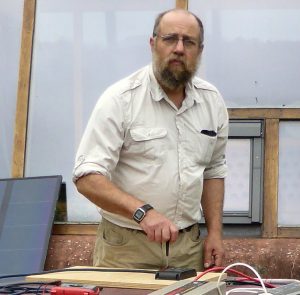
Those of you who have watched my YouTube channel will be familiar with the way I like to try things rather than listen to the armchair theorists. So, I have been experimenting again, spending a bit of cash, and learning things new to me. This idea however is not new and is startlingly obvious, but works because of a relatively recent piece of equipment called a grid diverter.
Let’s retrace our steps a bit. Previously, the accepted way of creating hot water from solar was through solar water panels, which are good and absorb different solar wavelengths from the solar electric panels. However to install such a water based system is quite disruptive, commonly involving changing hot water cylinders, fitting pressure tanks and lots of plumbing. Fine if you are doing a household refit, but problematic and the only outcome is lots of hot water.
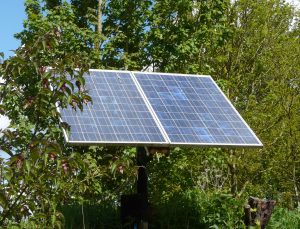
Consider the alternative in the light of developments in the solar electric world. Solar electric panels (photovoltaic panels) can be fitted anywhere where there is direct sunlight, on a frame in the garden, on your workshop roof, the chicken shed etc. These are easily connected by two wires to a grid inverter mounted somewhere in the dry and with a mains power connection. You can then use your standard immersion heater for hot water and there is no major disturbance. There are other benefits that I will come to later.
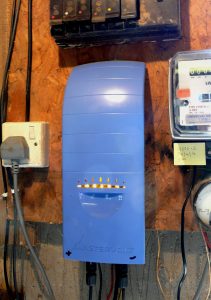
A grid tie inverter takes the direct current (DC) output from a number of solar panels (PV) and converts it into alternating current (AC) suitable to mix in with the mains electricity. Think about it as pouring electricity into your mains connection.
With a grid tie inverter the number and power of the panels need to be matched to the inverter, so the place to start is with the wattage. Each panel is rated for it’s nominal output in watts, so with a 1500 watt grid inverter you could use 6 panels rated at 235 watts, or 5 at 285 watts, but you do not have to fit the maximum number of panels as long as the collective panel voltage is within the grid inverter range. Different inverters have varying ranges, but I have noticed that the modern inverters have very wide acceptable working DC voltage range, something like 70 to 500 DC volts. This makes life easier as they will work with a wide range of panel numbers or specifications.
So as an example, take a grid inverter that works within the range of 130 to 320 volts. The 235 watt panels mentioned above will have an open circuit voltage of something like 37 volts. The panels are wired in series and this line of panels is called a string. Hence with six panels in a string the open circuit voltage will be: 6 x 37v = 222 volts, well within range. If you don’t have the room or cash for six panels you could fit five and that would still work but give out less power ( 37 x 5 = 185 volts). In the latter case the maximum output in good bright sunshine would be 235 x 5 = 1175 watts
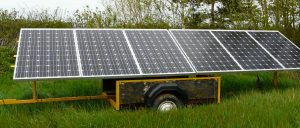
(1.17 Kw). As an alternative you could use a small 600 watt inverter like the blue Mastervolt that works between 40 and 150 volts and works well with 2 panels.
A grid inverter can be connected to any mains connection on your property as long as this will carry the power generated (the small ones are just plug in, see the Mastervolt photo). The power first goes into your home electrical circuit and helps to power the things using electricity at the time. If you don’t use it all then the surplus goes into the grid. If you use more than your generation then the extra is imported from the grid. So when the sun is shining that’s the best time to run the washing machine as you will mostly be powering it from your own genaration.
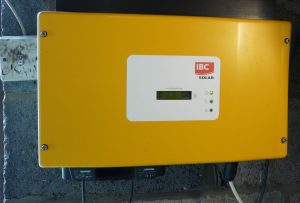
The price of photovoltaic panels (PV) has plummeted, my first panels were £3 per watt last decade, and a recent (and repeatable) purchase of panels was at 0.35p per watt. A similar drop in the solar grid tie inverters has occurred and a second hand market exists. All this in conjunction with a grid diverter means you can heat your water, run space heating, and contribute to powering your house from a system that is relatively easy to install.
So I have briefly described a grid tied PV system, but there is one more piece of equipment that pulls the whole thing together and makes it much more energy and cost effective. Namely the grid power diverter. Here is a video on my channel showing the installation on one of these units:
The Immersun diverter has a sensor that clips around one of your mains power supply cables next to your consumer unit. This tells the Immersun which way power is flowing and how much (import or export). There are several load circuits on the diverter and it powers these heating circuits only from your generated power, so if you are only generating 600 watts then that is all it will put into your immersion heater, and the diverted power will vary with the intensity of the sun on your panels ( and the number of panels). If you switch something on in the house then the generated power will go to that thing and the diverted power will reduce, or if it is a large electrical load it may import power. The main thing is that for the heating circuits connected to the Immersun no power will be drawn from the mains and so there will be no cost. There is a boost function for those grey days in winter and the use of this is down to family education. When your various heating circuits are up to temperature (max 3.2 Kw per circuit) and the thermostats have switched off then the surplus power in exported to the grid. This photo of the Immersun LCD screen shows the immersion heater up to temperature and the amount of electricity being exported. If you were running the washing machine at this point it would be zero carbon and zero cost.
So there you are, an alternative to solar water panels that is easy to fit, will power other things in the home, and can export power when you don’t need it.
Join me in Brighton on 16 June to find out more about this fascinating and life changing subject:
-:- https://brightonpermaculture.org.uk/photovoltaics
My video channel is here with lots of wind and solar ideas and experiments:
https://www.youtube.com/user/TheInfoworks/videos or browse Andy Reynolds Channel
-:- Andy Reynolds
Practitioner in lowimpact living and author of Wind and Solar Electricity
Available under our publications on this site (lowimpact.org)